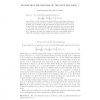Free Online Productivity Tools
i2Speak
i2Symbol
i2OCR
iTex2Img
iWeb2Print
iWeb2Shot
i2Type
iPdf2Split
iPdf2Merge
i2Bopomofo
i2Arabic
i2Style
i2Image
i2PDF
iLatex2Rtf
Sci2ools
JAT
2010
2010
On spectral polynomials of the Heun equation. I
The classical Heun equation has the form Q(z) d2 dz2 + P (z) d dz + V (z) ff S(z) = 0, where Q(z) is a cubic complex polynomial, P (z) is a polynomial of degree at most 2 and V (z) is at most linear. In the second half of the nineteenth century E. Heine and T. Stieltjes in [5], [13] initiated the study of the set of all V (z) for which the above equation has a polynomial solution S(z) of a given degree n. The main goal of the present paper is to study the union of the roots of the latter set of V (z)’s when n → ∞. We formulate an intriguing conjecture of K. Takemura describing the limiting set and give a substantial amount of additional information obtained using some technique developed in [7].
| Added | 28 Jan 2011 |
| Updated | 28 Jan 2011 |
| Type | Journal |
| Year | 2010 |
| Where | JAT |
| Authors | Boris Shapiro, Milos Tater |
Comments (0)

